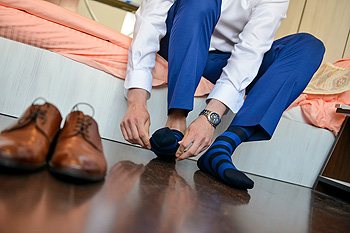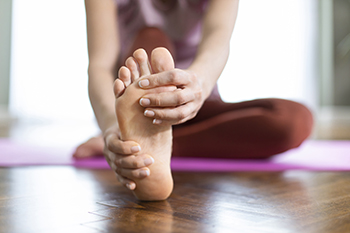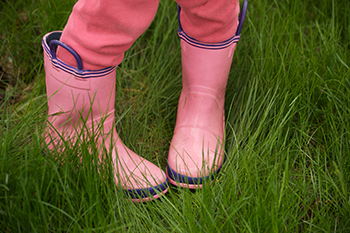
Wilmington (937) 382-2347
(513) 791-4764
Fax
(513) 932-1606

Wilmington (937) 382-2347
(513) 791-4764
Fax
(513) 932-1606

Your choice of footwear is more than just a fashion statement. Footwear significantly impacts the health of your feet. Whether you are navigating hard surfaces or engaging in physical activities, the shoes you wear can make a difference. For concrete or other hard surfaces, wearing supportive shoes with softer soles and arch support are essential to minimize foot pain and prevent issues like calluses and corns. Lace-up boots can offer relief by maintaining leg alignment, although they may limit ankle mobility. However, high heels can cause significant physical stress, altering foot position and posture and potentially lead to long-term damage. Sports enthusiasts should prioritize shoes with adequate cushioning and stability to prevent injuries. Custom-made orthotics tailored to your foot's unique needs can help to address specific issues and prevent further injury. Regularly alternating and replacing your shoes can vary foot posture and decrease the risk of injury. If you are experiencing foot problems or need guidance on proper footwear choices, it is suggested that you schedule an appointment with a podiatrist for an exam, diagnosis, and treatment plan.
Everyday foot care is very important to prevent infection and other foot ailments. If you need your feet checked, contact Dr. Gerald Perelman from Ohio. Our doctor can provide the care you need to keep you pain-free and on your feet.
Everyday Foot Care
Often, people take care of their bodies, face and hair more so than they do for their feet. But the feet are a very important aspect of our bodies, and one that we should pay more attention to. Without our feet, we would not be able to perform most daily tasks.
It is best to check your feet regularly to make sure there are no new bruises or cuts that you may not have noticed before. For dry feet, moisturizer can easily be a remedy and can be applied as often as necessary to the affected areas. Wearing shoes that fit well can also help you maintain good foot health, as well as making it easier to walk and do daily activities without the stress or pain of ill-fitting shoes, high heels, or even flip flops. Wearing clean socks with closed shoes is important to ensure that sweat and bacteria do not accumulate within the shoe. Clean socks help to prevent Athlete’s foot, fungi problems, bad odors, and can absorb sweat.
If you have any questions please feel free to contact our office located in Wilmington, OH . We offer the newest diagnostic and treatment technologies for all your foot and ankle needs.

Stiffness in the big toe, medically known as hallux rigidus, usually develops due to arthritis, especially in adults between 30 and 60 years old. This stiffness in the big toe is often found to be the result of past sports injuries. Symptoms can worsen over time, leading to persistent pain, difficulty in wearing shoes, and changes in the way you walk. Treatment options include non-surgical approaches, such as modifying footwear, adjusting activities, and using medications to manage pain and inflammation. In more severe cases, surgery may be necessary. One option is cheilectomy, where bone spurs are removed to improve joint movement. Another surgical option is arthrodesis, which involves fusing the joint to reduce pain. These procedures aim to alleviate symptoms and improve big toe function. Given the complexity of hallux rigidus, it is suggested that you consult a podiatrist for a thorough evaluation and the appropriate treatment recommendations.
Toe pain can disrupt your daily activities. If you have any concerns, contact Dr. Gerald Perelman of Ohio. Our doctor can provide the care you need to keep you pain-free and on your feet.
What Causes Toe Pain?
Most severe toe pain is caused due to a sports injury, trauma from dropping something heavy on the toe, or bumping into something rigid. Other problems can develop over time for various reasons.
Toe pain can be caused by one or more ailments. The most common include:
When to See a Podiatrist
Diagnosis
In many cases the cause of toe pain is obvious, but in others, a podiatrist may want to use more advanced methods to determine the problem. These can range from simple visual inspections and sensation tests to X-rays and MRI scans. Prior medical history, family medical history, and any recent physical traumatic events will all be taken into consideration for a proper diagnosis.
Treatment
Treatments for toe pain and injuries vary and may include shoe inserts, padding, taping, medicines, injections, and in some cases, surgery. If you believe that you have broken a toe, please see a podiatrist as soon as possible.
If you have any questions please feel free to contact our office located in Wilmington, OH . We offer the newest diagnostic tools and technology to treat your foot and ankle needs.

In-toeing, commonly known as being pigeon-toed, is a condition seen in children where the feet turn inward. During infancy, this might be due to metatarsus adductus, a common foot deformity noted at birth that causes the front half of the foot, or forefoot, to turn inward. This condition often resolves before the first birthday. In later childhood, internal twisting of the shinbone, tibia, thighbone, or femur, could be the cause of in-toeing. These, too, often self-correct over time. While most cases of in-toeing require no treatment, severe instances may need casting or splinting. It is important to avoid non-prescribed treatments as they may interfere with natural development. Though surgery is rare, it may be considered in severe cases. If your child’s in-toeing persists or significantly affects walking, it is suggested that you schedule an appointment with a podiatrist for a diagnosis.
The health of a child’s feet is vital to their overall well-being. If you have any questions regarding foot health, contact Dr. Gerald Perelman of Ohio. Our doctor can provide the care you need to keep you pain-free and on your feet.
Tips for Keeping Children's Feet Healthy
If you have any questions, please feel free to contact our office located in Wilmington, OH . We offer the newest diagnostic and treatment technologies for all your foot care needs.